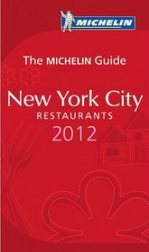

Just two weeks ago, New York became host to three new Michelin-starred Indian restaurants, prompting one to wonder, "Why here? Why now?"
London has long been home to Important Indian Restaurants, with dining establishments such as Amaya, The Cinnamon Club, Chutney Mary, and Benares rivaling some of the town's best French restaurants. And Vancouver's upper crust would just as soon eat at Vij's, an ambitious, upscale Indian eatery of international repute, than at any of the city's tonier non-ethnic spots.
But for decades in New York, Indian food traditionally has been burdened with a reputation for being "cheap and cheery," and its restaurants are largely confined to pockets of "curry ghettos" around the city. I've believed that the cuisine's spicing, and its menu offerings, were too esoteric even for foodies to fully comprehend, making it a challenge to tell mediocre meals from good or great. There were a smattering of elegant spots, including Dawat, Devi and the original Tamarind, but they were often treated as "special occasion" places.
In 1998, Danny Meyer opened a spectacular Indian restaurant in New York called Tabla, and I recall enjoying chef Floyd Cardoz's "interpretive" food there often. But despite great marketing and lots of favorable press, the restaurant never gained traction and closed after a 12-year run last December.
So it's highly ironic that less than a year later the Michelin guide has just blessed three Indian restaurants here with a star apiece while Tabla's former space now houses a Peruvian ceviche emporium. Michelin anointed Junoon, Tulsi (both in their first year of business) and Tamarind Tribeca (an offshoot of an older and unstarred Tamarind not far from Tabla) with the coveted rating. "Holy Cow! Break the coconuts, sound the Tabla, play the harmonium. Sing that Badwa-Randi song Chamak Challo," proclaimed the Indian blog SearchIndia.com upon hearing the news.
To put it in perspective, from thousands of restaurants in the city, Michelin chose only seven to receive 3-stars, nine restaurants merited 2-stars, and 46 got 1-star - three of which were Indian. Of course, these three all were in Manhattan, and a trip to Jackson Heights, in Queens, might have revealed a few more candidates - but no matter, the recognition is there.
Junoon is extremely elegant, spacious, and cost a rajah's ransom to build. It serves more-or-less modern Indian food with Frenchified service - of the sort one might find in five-star hotels in Mumbai or Delhi. Its environment only can be described as opulent-and-then-some. Its menu is written primarily in English, its language non-threatening, and its spicing a bit modulated. The chef is good-looking Vikas Khanna, who is no stranger to the TV screen; the owner is Rajesh Bhardwaj of Café Spice fame. New York Times' former critic, Sam Sifton, loved the notion that you could order a bottle of "2006 Valpolicella Grassi with your monkfish tikka."
Tulsi, which bills some of its items as "street food" brought indoors, is more traditional, its menu language less navigable, but its food rings truer. The impresario and chef here is the beloved Hemant Mathur, who was an owner and chef at Devi, and headed the kitchen at other Indian notables such as Amma and Tamarind. His butter chicken, Manchurian cauliflower, and tandoori lamb can bring tears to your eyes. I am personally thrilled for his success and this recognition by Michelin who deemed Tulsi "the incomparable one."
The new Tamarind in Tribeca, also in spectacular surroundings, goes for highly decorative plating of its dishes - and this is something fairly new among the town's Indian restaurants where food generally comes wallowing in one sort of sauce or another. In fact, the menu is so elegant and luxurious sounding that you might want to enroll in a graduate seminar in Indian culinary history to fully grasp their intentions. The vegetarian selections alone might encourage you to become one. In addition to their Michelin star, the 2011 Zagat gives an appreciative 26 point rating for the food.
While this is all a far-cry from the $6.99 buffet lunch at Chennai Gardens that I have enjoyed over the years, there's not much commonality among the chosen three, other than that none is located in Curry Hill and all are more expensive than your typical Indian bistro
I've had many splendid Indian meals, but mostly in India. One of my all-time favorites is Masala Kraft, in the historic Taj Hotel in Mumbai, a high-energy destination for the city's glitterati, where classic food has been "lightened" without sacrificing authenticity. I long for it to open in New York as it would no doubt add to the list of Michelin treats.
Does this mean that, finally, Indian food is hot? Is there a trend building? Or is Michelin over-reaching? Perhaps it's all of the above, including a post-recession boom that is allowing us to throw wads of money at previously cheap food, and a willingness to embrace the palate-tingling, exoticism of India's culinary landscape.
The good news is we no longer have to go to London, or India, to get great Indian food.
